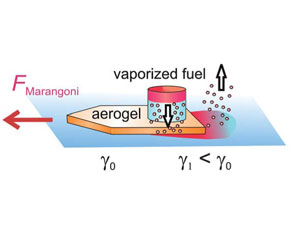 A small autonomous boat powered by a volatile surfactant has been developed by scientists in Finland and Israel. The surfactant modifies the surface tension of the liquid it floats on to create a surface tension gradient that propels the boat forward.
A small autonomous boat powered by a volatile surfactant has been developed by scientists in Finland and Israel. The surfactant modifies the surface tension of the liquid it floats on to create a surface tension gradient that propels the boat forward.
Propulsion induced by a surface tension gradient is known as Marangoni propulsion. It’s used in nature by small creatures such as Microvelia (small aquatic insects) to give a burst of speed to escape predators. In man-made devices, the Marangoni effect has been used to power small ‘camphor boats’ and ‘soap boats’; however, these systems normally offer only short term propulsion or require the boat to be confined to specific channels.
To develop a longer-term propulsion system, the team led by Robin Ras at Aalto University, Finland, created a boat from a lightweight membrane made from a nanocellulose aerogel. The membrane is impermeable to water (and oil) but it allows the gaseous surfactants to pass through it. The team used ethanol as the fuel to power a boat floating on water.
Read the full article in Chemistry World
Link to journal article
Vapour-driven Marangoni propulsion: continuous, prolonged and tunable motion
Hua Jin, Abraham Marmur, Olli Ikkala and Robin H. A. Ras
Chem. Sci., 2012, Advance Article, DOI: 10.1039/C2SC20355C, Edge Article










